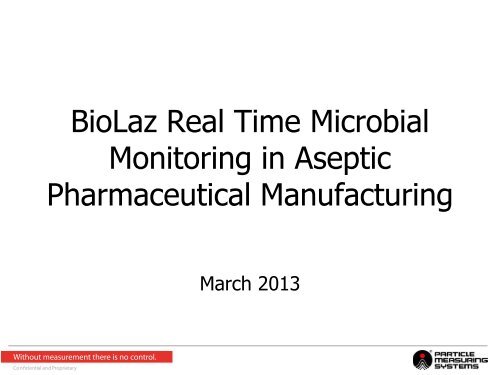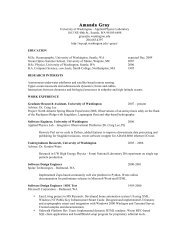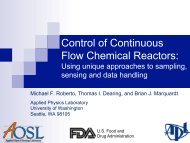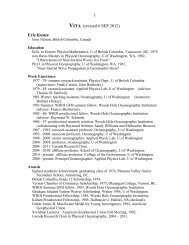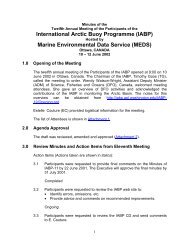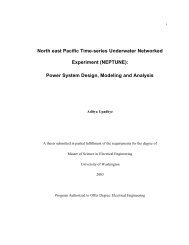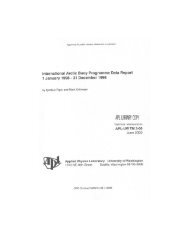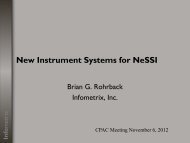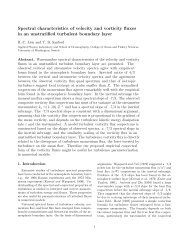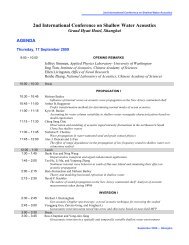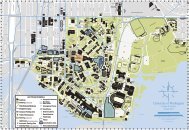Introducing BioLaz - CPAC
Introducing BioLaz - CPAC
Introducing BioLaz - CPAC
You also want an ePaper? Increase the reach of your titles
YUMPU automatically turns print PDFs into web optimized ePapers that Google loves.
<strong>BioLaz</strong> Real Time MicrobialMonitoring in AsepticPharmaceutical ManufacturingMarch 2013
IntroductionsGilberto Dalmaso,PMS Global Aseptic ProcessesDevelopment Manager
Who We Are:• Particle Measuring Systems Inc.• HQ in Boulder, Colorado, USA• Founded in 1972• Acquired by Spectris plc in 1996• Global leader in contamination controlinstrumentation• Inventors of laser-based particle counting• Over 40 patents
Our Profile:• Cross- industry specialists forthose cleaner-than-natureenvironments and materials• Product lines• Particle counters• Microbial air samplers• Molecular gas analyzers• Software and systems• Services• What we do• Design• Manufacture• Service• Educate
Microbiological MonitoringToday….
EU GMP LimitsAT RESTIN OPERATIONGRADE Max Particle concentration > size Microbiological0.5um5.0um 0.5um 5.0umAir Samplecfu/m^390mmsettle platecfu/4hrA 3 520 20 3 520 20
Typical active air sampling –portable samplers:• Samples taken atbeginning or end ofbatch manufacturing• Risk of contaminationfrom personnel ifsampling during filling• Typically 1 m 3 samplein 10 minutes
Limitations of portable viable samplers:• At best do not monitor, but – like portableparticle counters, take intermittent samples• Media desiccation limits sample duration to 1-2m 3 (10-20mins sample time)• Introduce people into sterile areas (risk)• Great risk the introduction in grade A forexhaust air• No real-time indication of bacteria
Real Time Microbial Monitoring
Fixed point microbiologicalmonitoring• Located at many of the same points identified byrisk analysis for the non-viable (particle)monitors• Sampling ideally during every batch• Slower sampling an advantage - to representconditions during a greater proportion of eachbatch, before media becomes desiccated
Limitations of Impactiontechnologies:• Still an impaction based technology using agarmedium, with its desiccation / biologicalrecovery limitations• No real time indication of bacteria, therefore noreal-time process control
FDA PAT initiative• Industry is pushing for continuous methods tocontrol the aseptic process to ensure quality bydesign (QBD)• Ideally this requires a means of detecting viableorganisms real-time• Non-viable particle counting fits with PAT, butcannot tell the difference between live particlesand inert ones
Rapid Microbial Methods
<strong>BioLaz</strong> Base Technology
Cell Structure• All living cells comprise of specific chemical compoundsthat allow for the metabolism of energy.• A catalyst of those reactions is the co-enzyme NADH.
Cell Fluorescence• NADH has a fluorescence of 460nm when excited at 405nm• This fluorescence is a clear indicator of cell activity and is directlyassociated with “living” cells, i.e. those metabolizing.• Other cell components also exhibit a fluorescent emission –including NADH, Riboflavin and Dipicholinic acid in spores
Optical Fundamentals• The sample is pulled through the optical chamber and illuminated bythe UV laser source.• Elastic light scatter occurs when a particle enters a laser beam.• The trigger from the elastic light scatter activates the fluorescencecircuit to detect any fluorescence from that particle at a wavelengthshift.• Filters ensure only the active component of fluorescence is detectedand the scattered light does not interfere with the signal
Bio-fluoresenceTechnology• 405nm laser light illuminates sample air flow through thesensor• ALL particles, viable and nonviable, scatter light• Living organisms fluoresce (NADH (nicotinamide adeninedinucleotide), Riboflavin and Dipicholinic Acid in viableorganisms will fluoresce at ~ 460nm)• <strong>BioLaz</strong> simultaneously detects both scattered light andfluorescence• Nonviable particles only scatter light• Viable particles scatter light and fluoresce• 1 fluorescent particle = 1 Bio-Count
Data Output – 4 channels• Small Particles (c.f.>0.5um)• Large Particles (c.f.>5um)• Small Biological Particles (c.f.>0.5um)• Large Biological Particles (c.f.>5um)
Our Approach• Step 1: – Can we validate instrument performance toUSP and EP?• Step 2: Validate that common chemicals and materialsin the aseptic environment do not interfere• Step 3: Integrate <strong>BioLaz</strong> into our currentenvironmental monitoring system• Step 4: Establish operational levels in asepticenvironments• Step 5: Dialogue with regulatory bodies to establishcriteria for operational use
USP / EP Validation
Validation Test Overview• Objective• To validate the <strong>BioLaz</strong> according to USP Validation ofAlternative Microbiological Methods and EP 5.1.6 AlternativeMethods for Control of Microbiological Quality• Use of an Independent Test Facility• Edgewood Chemical and Biological Center (ECBC)• Facility has expertise in single biological particle generation andrecovery• Known microorganism• Known particle size• Known concentration of challenge
USP and EP 5.1.6Not requiredRequired
Validation Protocol
Validation Test Setup
Biological Particle Generator• Ink Jet Aerosol Generator (IJAG)• Adapts ink jet printer technology forthe production of well controlled andwell characterized aerosols• Three components:• Dispenser• Controller• ComputerHigh-speed images of particleejection (in air) by IJAG• Left to right = time (frames)• Top to bottom = distance
Initial Microorganisms Tested:• 4 organisms tested using a single particle test method• Bacillus Subtilis (Bs), vegetative form• Bacillus Globigii (Bg), spore form, washed• Bacillus Globigii (Bg), spore form, unwashed• Bacillus Thuringiensis (Bt), spore form, washed• Supplemental testing of 4 organisms using the traditionalbio-aerosol test method (high concentration aerosol challenge)• Staphylococcus epidermidis• Bacillus Thuringiensis• Aspergillus Niger• Yeast
Test Methodology5-minBlankt=05-minBlank• One complete test cycle was:1) 5 minutes blank at Zero Concentration2) 5 minutes at Concentration 1(One particle every 12 seconds: 25 total)3) 2 minutes blank4) 5 minutes at Concentration 2(One particle every 9 seconds: 33 total)5) 5 minutes blank• Blank periods provide cleanseparation and verify zero detectioncapability• Test cycle was completed separatelyfor <strong>BioLaz</strong> then slit-to-agar sampler• Cycle was repeated five times foreach organism at 5 µm particle size• Sixth test was then run at 3 µm size5-minConc. 12-min BlankConc 1 Blank Conc 25-minConc. 2
Test Results Summary (concentration 1)• <strong>BioLaz</strong> passed all USP and EP 5.1.6 requirements• Above summary is for parameters deemed most critical to success
Test Results Summary (concentration 2)• <strong>BioLaz</strong> passed all USP and EP 5.1.6 requirements• Above summary is for parameters deemed most critical to success
Example of Individual Bs TestCultured Plate CFU Results<strong>BioLaz</strong> Bio-Count Results
Bs Replicate Data Summary
Bs Linearity
Bs Validation Table
Initial EP /USP ValidationConclusions:• Meets or exceeds the guidelines established in USP and EP 5.1.6 for Validation of AlternativeMicrobiological Methods• Capable of single Bio-Count detection andquantification• One Bio-Count is representative of CFU• The accuracy at multiple concentrations with differentspecies of microorganisms passes the USP and EPrequirements• The instrument does not require special handling,training or logistics to operate
Our Approach• Step 1: – Can we validate instrument performance toUSP and EP?• Step 2: Validate that common chemicals and materialsin the aseptic environment do not interfere• Step 3: Integrate <strong>BioLaz</strong> into our currentenvironmental monitoring system• Step 4: Establish operational levels in asepticenvironments• Step 5: Dialogue with regulatory bodies to establishcriteria for operational use
Can common disinfectants /cleaning materials give falsepositive results?
Additional Testing• False positive testing:• Conducted additional testing with formalized method usingchemicals found in clean rooms: Isopropyl alcohol 70% Hydrogen peroxide 6% Sodium Hypochlorite 6% Quaternary Ammonium Phenolics Peracetic acid/ hydrogen peroxide Decon-Clean• Conduct additional testing with formalized method using materialsfound in clean rooms: Latex/Nitrile gloves Cleanrooms garments Cleanroom ISO 5 wipes
Shield Medicare BiocidesDate Description Date Time Large Bio Small Bio Large Particle Small ParticleBiocide A 1 spray 07/11/20129:12:56 AM 9:13:26 AM 0 0 0 122Biocide A 1 spray x2 9:13:36 AM 9:14:36 AM 12 6 24 365Biocide A 2 sprays 9:14:46 AM 9:15:46 AM 41 34 61 847Biocide A 2 sprays x2 9:15:56 AM 9:17:36 AM 38 27 49 1179Biocide A Nebulized 2:00:56 PM 2:12:06 PM 0 1 0 3870Biocide B 1 spray 9:18:56 AM 9:19:36 AM 0 0 1 43Biocide B 1 spray x2 9:19:46 AM 9:20:16 AM 0 0 2 32Biocide B 2 sprays 9:20:26 AM 9:21:06 AM 1 0 6 52Biocide B 2 sprays x2 9:21:16 AM 9:21:46 AM 0 0 4 29Biocide B Nebulized 2:16:16 PM 2:27:37 PM 0 1 0 15655Biocide C 1 spray 9:24:26 AM 9:24:56 AM 0 0 0 23Biocide C 1 spray x2 9:25:06 AM 9:25:46 AM 0 0 0 34Biocide C 2 sprays 9:25:56 AM 9:26:36 AM 0 0 0 92Biocide C 2 sprays x2 9:26:46 AM 9:28:36 AM 0 0 0 49Biocide C Nebulized 2:31:27 PM 2:42:17 PM 0 0 1 12Biocide D Nebulized (Not availablein trigged spray bottle)2:46:07 PM 2:57:17 PM 0 1 0 406Biocide E 1 spray 9:30:56 AM 9:31:36 AM 0 0 9 3107/11/2012Biocide E 1 spray x2 9:31:46 AM 9:32:16 AM 0 0 14 32Biocide E 2 sprays 9:32:26 AM 9:33:07 AM 1 0 39 106Biocide E 2 sprays x2 9:33:16 AM 9:34:36 AM 0 0 30 116Biocide E Nebulized 3:00:37 PM 3:11:08 PM 0 0 0 6454Biocide F 1 spray 9:35:37 AM 9:36:17 AM 0 0 0 11Biocide F 1 spray x2 9:36:27 AM 9:36:47 AM 0 0 0 36Biocide F 2 sprays 9:36:57 AM 9:37:47 AM 0 0 1 65Biocide F 2 sprays x2 9:37:57 AM 9:39:17 AM 0 0 0 76Biocide F Nebulized 3:14:58 PM 3:26:28 PM 0 0 0 570/30 sterile IPA 1 spray 9:40:07 AM 9:40:47 AM 0 0 0 2970/30 sterile IPA 1 spray x2 9:40:57 AM 9:41:27 AM 0 0 0 3570/30 sterile IPA 2 sprays 9:41:37 AM 9:42:17 AM 0 0 0 2970/30 sterile IPA 2 sprays x2 9:42:27 AM 9:42:57 AM 0 0 2 18Sterile IPA Nebulized 3:29:58 PM 3:40:58 PM 0 0 0 0denatured ethanol 1 spray 9:46:47 AM 9:47:17 AM 2 0 10 32denatured ethanol 1 spray x2 9:47:27 AM 9:47:57 AM 0 0 0 24denatured ethanol 2 sprays 9:48:07 AM 9:48:47 AM 3 0 12 185denatured ethanol 2 sprays x2 9:48:57 AM 9:50:07 AM 0 0 0 31Denatured Ethanol Nebulized 3:44:48 PM 3:54:38 PM 0 0 0 0DI water sterile 1:55:56 PM 3:57:08 PM 0 0 0 101
Veltek BiocidesDescription Date TimeLarge SmallBio BioLarge Particle Small ParticleDecon Spore Nebulized 08/11/2012 8:08:01 AM 8:19:01 AM 0 0 0 1603 Undiluted: Not available in trigger sprayDecon Phene 1 spray 08/11/2012 9:34:05 AM 9:34:55 AM 0 0 0 13Decon Phene 1 spray x2 08/11/2012 9:35:05 AM 9:36:05 AM 1 0 2 21Decon Phene 2 sprays 08/11/2012 9:36:15 AM 9:37:25 AM 0 4 1 97Decon Phene 2 sprays x2 08/11/2012 9:37:35 AM 9:41:35 AM 12 12 27 388Decon Phene Nebulized 08/11/2012 8:23:21 AM 8:33:54 AM 0 0 0 69Steri Perox 1 spray 08/11/2012 9:28:45 AM 9:29:35 AM 1 0 3 2Steri Perox 1 spray x2 08/11/2012 9:29:45 AM 9:30:35 AM 0 0 0 1Steri Perox 2 sprays 08/11/2012 9:30:45 AM 9:31:55 AM 0 0 0 15Steri perox 2 sprays x2 08/11/2012 9:32:05 AM 9:32:55 AM 0 0 0 15Steri perox Nebulized 08/11/2012 8:38:04 AM 8:48:54 AM 0 0 0 0Decon clean Nebulized 08/11/2012 8:53:14 AM 9:03:54 AM 0 1 3 37891 Undiluted: Not available in trigger sprayDecon quat Nebulized 08/11/2012 9:08:04 AM 9:18:54 AM 0 2 6 71423 Undiluted: Not available in trigger sprayDI Water Nebulized 08/11/2012 8:04:01 AM 9:26:45 AM 0 0 0 262
Biocide testing:• Nebulized Biocides cause negligible backgroundinterference• Direct spray interference levels unlikely to beproblematic in operational conditions in Class A& B
Materials tests• Nitrile Gloves• Cleanroom Gowns• Wipes, cloths• The presence of whiteners or cellulose cancause some level of fluorescence breakthrough,but these were only seen whilst directly injectingmaterial into the Biolaz inlet and tests in normalcleanroom usage suggest this is not a significantsource of counts.
Our Approach• Step 1: – Can we validate instrument performance toUSP and EP?• Step 2: Validate that common chemicals and materialsin the aseptic environment do not interfere• Step 3: Integrate <strong>BioLaz</strong> into our currentenvironmental monitoring system• Step 4: Establish operational levels in asepticenvironments• Step 5: Dialogue with regulatory bodies to establishcriteria for operational use
Integration with a Monitoring SystemTechnical AreaFacilityProEthernetLANITVacuumPumps(hot swapcontrol)SCADA serverSCADA clientsVacuumEthernetRedundant serverExternal DB(Oracle, SQL,...)Analog& DigitalI/OBioCaptmicrobialsamplers<strong>BioLaz</strong>real-timemicrobialmonitorIsoAirparticlesensorsEnv.sensorsAlarmsCritical Cleanrooms (A/B)HMIClientsdatadownloadportsLasair IIIparticlecountersMiniCaptmicrobialsamplersBackground Cleanrooms (C/D)
System Integration• Biolaz is not seen as a substitute forconventional microbiological methods, but aprocess control device for real-time microbialindication• By incorporating Biolaz data along with particlecounts and other environmental parameters, itbecomes a tool to assist in determininginterventions or process checks, based ongathered data
5 Steps of Biolaz Integration1) Qualification of instrument for alternativemicrobial methods.• Completed, with full supporting validation for USP/EPqualification from PMS2) Installation Qualification of instrument.3) Operational Qualification of instrument.4) Performance Qualification of instrument.5) Integration into Environmental Monitoringprogram for release of product.
Installation QualificationProbe & TubingComputerData Cable• Instrument mounting• Orientation• External obstructions to cleanroom• Location relative to sample point• Sample Probe & Tubing• Orientation of sample probe – isoaxial+/- 15%• Tubing length not to exceed 1.0m(ISO14644-3)• Tubing materials, connectorsPower• Power Supply• 110 or 240V fed from where?• Circuit number, conduit requirements,• isolation of power• Communications• RS232 or Ethernet• Cable type, low smoke, CAT5, shielding• Convertor devices for long distances• Hubs for multiple instruments within a facility
Operational Qualification• Hardware Errors• Power loss• Sample probe blocked• Data cable broken• Laser / Flow failure• Alarm Response• System colour changes on screen• External alarm devices• Email / SMS text paging responses andconfiguration• Data formats available• Historical data• Time Plots• Data Reports and data export• Security of SCADA package• 21CFR 11 – E’records & E’Sigs• Archived data retrieval
Performance Qualification• Verify against current practices and set statistically appropriate alarmand alert limitsEU GMPAnnex 1PIC/Sinterpretationof Annex 1• This is a sensor – like particle counting so “Appropriate” alarms should be applied• 0000000000000000001000000000000000000110000000 = alarm..?• 1111010201010601021001200202020010100012012011 = alarm• Cubic Meter Monitoring• flow is 4 LPM, to take a 1m 3 sample it would take apx 4 hours, therefore 2m 3 pershift, this is in line with current practices
<strong>BioLaz</strong> Benefits – Real TimeAlarm on viable organisms• When used in conjunction with a non-viableparticle counting system (FMS), Biolaz canindicate whether a contamination event containslive organisms – allowing rapid response• When results from both non-viable monitoringand <strong>BioLaz</strong> indicate all is in limits, greatercertainty of batch release is assured.• Consistent with the PAT approach
Incorporation into EnvironmentalMonitoring Program• Once statistically valid, action and alert limits can be set and thesecorrelated against:• Traditional particle counting• Microbial samples – active air + settle plates• Media fill finished product quality data• Reviewed on a routine basis ensuring creditable alarms:• Not so many alarms as to cause a nuisance• Not so few as to not be able to demonstrate control• Review of EM program to monitor number of traditional samplesrequired to demonstrate control• 99.9% of plates read zero• A reduction of half would significantly alter the workload on microbiologygroups• NOT proposing to not do plates – speciation, fail safe, maintenance, etc.• <strong>BioLaz</strong> Real-time Microbial data is included into environmentalmonitoring records for product release
Applications
Monitoring Applications• Filling lines• Classic hard and soft wall filling lines• Isolator and RABS technologies• Grade B background zones• Sterility test isolators• Critical to ensuring product environmentwas suitable prior to test – false fail.• Biosafety cabinets• Critical activities of manual formulationslasting a short period, unsuitable fortraditional techniques• Aseptic transfers• Short duration activities lasting a fewminutes, connection of aseptic piping tofill line from vessel.
Monitoring Applications• Biotech & Radioactive products• Where the product is formulated for specificpatients requiring a short time from product topatient.• Typical cycles are
<strong>BioLaz</strong> Benefits• Faster batch release• Partitioning of finished product (based on timing of alarms)• Immediate notification for alarm response• Verify biological levels are acceptable prior to filling or sterilitytesting• Reduced operator error• Paperless data management+ + =Compliance andCost ReductionTraditionalmicrobialReal-timemicrobialReal-timeparticle
Conventional Microbiology + RMM• You still need to perform conventional viablesampling – as organism identification is requiredby GMP. This requires agar cultivation andspeciation.• Current Annex 1 limits are set for traditional airsampling methods. No RMM levels are yet inplace.
Our Approach• Step 1: – Can we validate instrument performance toUSP and EP?• Step 2: Validate that common chemicals and materialsin the aseptic environment do not interfere• Step 3: Integrate <strong>BioLaz</strong> into our currentenvironmental monitoring system• Step 4: Establish operational levels in asepticenvironments• Step 5: Dialogue with regulatory bodies to establishcriteria for operational use
Biolaz in a Working AsepticManufacturing Facility
0:00:070:34:271:08:481:43:112:17:312:51:523:26:124:00:334:34:545:09:145:43:356:17:556:52:167:26:368:00:598:35:239:09:569:44:1910:18:4010:53:0011:27:2112:01:4112:36:0213:10:2313:44:4314:19:0414:53:2415:27:4516:02:0516:36:2617:10:4617:45:0718:19:3918:54:0019:28:2420:02:4420:37:2421:11:4521:46:0622:20:2622:54:4723:29:07BIOLAZGRADE A - AT REST21.81.61.41.210.80.6Small BioLarge Bio0.40.20
0:00:070:35:171:10:281:45:412:20:512:56:023:31:134:06:234:41:345:16:445:51:556:27:057:02:167:37:268:12:398:48:059:23:199:58:2910:33:4011:08:5111:44:0112:19:1212:54:2213:29:3314:04:4314:39:5415:15:0515:50:1516:25:2617:00:3617:35:4718:11:0918:46:2019:21:3419:56:4420:32:0221:07:2521:42:3622:17:4622:52:5723:28:07BIOLAZGRADE A - AT REST20181614121086Large ParticleSmall Particle420
00.511.522.50:00:020:32:561:05:461:38:402:11:302:44:213:17:113:50:024:22:534:55:435:28:366:01:266:34:177:07:077:40:008:12:508:45:419:18:359:51:2510:24:1610:57:0611:29:5712:02:4712:35:3813:08:2813:41:2414:14:1414:47:0515:19:5615:52:4916:25:4516:58:3617:31:2618:04:1718:37:0719:09:5819:42:4820:15:3920:48:2921:21:2021:54:2422:27:1523:00:0523:32:56Large BioSmall BioBIOLAZGRADE A IN OPERATION
BIOLAZGRADE A IN OPERATION0123456780:00:020:33:361:07:061:40:402:14:102:47:413:21:113:54:424:28:135:01:435:35:166:08:476:42:177:15:487:49:208:22:518:56:249:29:5510:03:2510:36:5611:10:2611:43:5712:17:2712:50:5813:24:3413:58:0414:31:3515:05:0515:38:3616:12:1516:45:4517:19:1617:52:4618:26:1718:59:4719:33:1820:06:4920:40:1921:13:5021:47:3422:21:0522:54:3523:28:06Large ParticleSmall Particle
0:00:010:31:211:02:421:34:022:05:232:36:433:08:043:39:244:10:454:42:055:13:265:44:466:16:076:47:277:18:487:50:088:21:298:52:499:24:109:55:3010:26:5310:58:1311:29:3412:00:5412:32:1513:03:3513:34:5614:06:1614:37:3715:08:5715:40:1816:11:3816:42:5917:14:1917:45:4018:17:0018:48:2119:19:4119:51:0220:22:2220:53:4321:25:0321:56:2422:27:4422:59:0523:30:25BIOLAZGRADE B - AT REST21Large BioSmall Bio0
0:00:010:31:211:02:421:34:022:05:232:36:433:08:043:39:244:10:454:42:055:13:265:44:466:16:076:47:277:18:487:50:088:21:298:52:499:24:109:55:3010:26:5310:58:1311:29:3412:00:5412:32:1513:03:3513:34:5614:06:1614:37:3715:08:5715:40:1816:11:3816:42:5917:14:1917:45:4018:17:0018:48:2119:19:4119:51:0220:22:2220:53:4321:25:0321:56:2422:27:4422:59:0523:30:25BIOLAZGRADE B - AT REST54321Large ParticleSmall Particle0
BIOLAZGRADE B IN OPERATION00.511.522.50:00:090:31:031:01:531:32:442:03:342:34:253:05:153:36:054:06:594:37:495:08:405:39:306:10:216:41:117:12:027:42:528:13:438:44:399:39:4710:10:3810:41:2811:12:1911:43:0912:14:0012:44:5013:15:4113:46:3114:17:2214:48:1415:19:0515:49:5816:20:4816:51:3917:22:2917:53:1918:24:1018:55:0019:25:5119:56:4120:27:3220:58:2221:29:1322:00:0622:30:5623:01:4723:32:40Large BioSmall Bio
BIOLAZGRADE B IN OPERATION01234567890:00:090:31:031:01:531:32:442:03:342:34:253:05:153:36:054:06:594:37:495:08:405:39:306:10:216:41:117:12:027:42:528:13:438:44:399:39:4710:10:3810:41:2811:12:1911:43:0912:14:0012:44:5013:15:4113:46:3114:17:2214:48:1415:19:0515:49:5816:20:4816:51:3917:22:2917:53:1918:24:1018:55:0019:25:5119:56:4120:27:3220:58:2221:29:1322:00:0622:30:5623:01:4723:32:40Large ParticleSmall Particle
BIOLAZ evaluationSummary data09 dec.10 dec.11 dec.12 dec.13 dec.14 dec.15 dec.16 dec.17 dec.18 dec.volume large bio large particle small bio small particle Gradetotal (5,76 m 3 ) 0 3 5 530total m 3 0 0,52 0,86 92grade A at resttotal (5,76 m 3 ) 5 10 9 1394 grade A intotal m 3 0,86 1,74 1,56 242operationtotal (5,76 m 3 ) 5 11 7 609 grade A intotal m 3 0,86 1,91 1,21 105,73 operationtotal (5,76 m 3 ) 6 12 10 895 grade A intotal m 3 1,04 2,08 1,74 155,38 operationtotal (5,76 m 3 ) 2 2 15 6597total m 3 0,34 0,34 2,6 1145grade A cleaningtotal (5,76 m 3 ) 5 18 34 873 grade B intotal m 3 0,86 3,12 5,9 155,9 operationtotal (5,76 m 3 ) 0 3 2 885total m 3 0 0,52 0,35 153,6grade B at resttotal (5,76 m 3 ) 3 3 4 558total m 3 0,52 0,52 0,69 96,87grade B at resttotal (5,76 m 3 ) 13 95 75 4444 grade B intotal m 3 2,25 16,49 13,02 771,52 operationtotal (2,4 m 3 ) 2 24 15 516 grade B intotal m 3 0,83 10 6,25 215operation
Summary• Grade A at rest – 0.5 bio-counts / m3• Grade A operational - 2 bio-counts / m3• Grade B at rest – 0.5 bio-counts / m3• Grade B operational – 10 bio-counts / m3
Calibration
CalibrationNebulizer with PSL’s andfluorescing particlesReferenceParticle CounterReference UnitUnit Under Test (UUT)Ethernet cables• Calibration based on comparison to reference unit.• Nebulized 0.7 & 1.5 m PSL’s for particle channels• Nebulized BHA Green Visolite calibration spheres for fluorescent channels.• Specific number of counts in the large channel (>2m) and specific number in smallchannel (0.5-2m) essentially ‘splitting’ the sizing threshold.• System verified as operational using a mixture of Visolite, Riboflavin and 0.7 m particles• Calibration performed at customer site or back at laboratory.
Sensor CalibrationThe software automatically starts generating calibration particles into both sensors and adjusts settings onthe sensor to match the particle counts, size ratio, and fluorescence signals to the referee sensor.Each adjustment is represented as a vertical black line on the graph showing where the change was made.Once that data point is properly calibrated, the vertical line turns green.Threshold boxes turngreen when calibration issuccessfulThese thin grey linesshow the upper andlower tolerance levels fora successful calibration.The “Calibration Actions”box shows a text displayof the calibration processas it’s occurringpage 73
Calibration Certificate• Instrument details• Serial number• Model number• Calibration Details• Sensor thresholds• Response to calibrationmedia• Comparison againstreference• Details of media used• Expiration date• 12 month expiration
<strong>BioLaz</strong> Summary• Real-time, continuous microbial monitoring isnow possible• System integration with traditional monitoringsystems provides no-risk qualification path• Small 316L stainless steel enclosure• No maintenance or consumables• Annual calibration as with existing environmental sensors• Validated to USP and EP requirements
Our Approach• Step 1: – Can we validate instrument performance toUSP and EP?• Step 2: Validate that common chemicals and materialsin the aseptic environment do not interfere• Step 3: Integrate <strong>BioLaz</strong> into our currentenvironmental monitoring system• Step 4: Establish operational levels in asepticenvironments• Step 5: Dialogue with regulatory bodies to establishcriteria for operational use
Questions?


